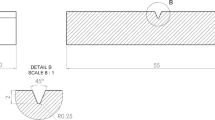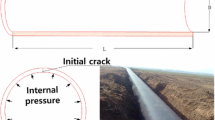Abstract
Detonation-driven fracture problems in tube under dynamic load have received plenty of attention because of various ranges of applications, such as oil and gas pipeline systems, new rocket engine such as pulse detonation engine, and pressurized aircraft fuselages. This paper reports the crack growth modeling in a thin aluminum tube under gaseous detonation load. Because of three-dimensional fracture dynamics with gas dynamics coupled phenomena, analytical modeling is complicated. Thus, a finite element method was applied. The finite element modeling and simulation of the tube under detonation moving load were performed using commercial code Abaqus. This simulation leads to obtain structural response of the tube to detonation load. The simulations were compared with experimental and analytical results from the literature for elasto-dynamic response of cylindrical shells with finite length under internal detonation loading. Cohesive element with traction–separation law was used for crack growth modeling along with crack tip opening displacement value obtained from experimental–numerical analysis from previous research. The final section of the paper is dedicated to investigating differences and comparisons between the numerical crack propagation simulations and experimental results reported in the literature. It has been demonstrated that using cohesive elements with some modifications can improve the numerical accuracy. The obtained results are more similar to the experimental results than numerical results available in literature.












Similar content being viewed by others
Abbreviations
- CJ:
-
Chapman–Jouguet
- CTOA:
-
Crack tip opening angle
- CTOD:
-
Crack tip opening distance
- CZ:
-
Cohesive zone
- FE:
-
Finite element
- T–S:
-
Traction–separation
References
Chao TW (2004) Gaseous detonation-driven fracture of tubes, Dissertation, California Institute of Technology
Chao TW, Shepherd JE (2005) Fracture response of externally flawed aluminum cylindrical shells under internal gaseous detonation loading. Int J Frac 134(2):59–90. doi:10.1007/s10704-005-5462-x
Tang S (1965) Dynamic response of a tube under moving pressure. Proc Am Soc Civil Eng 5:97–122
Reismann H (1965) Response of a pre-stressed cylindrical shell to moving pressure load. In: Ostrach S, Scalon RH (eds) Eighth Midwest Mechanics Conference, pp 349–363
de Malherbe MC, Wing RD, Laderman AJ, Oppenheim AK (1966) Response of a cylindrical shell to internal blast loading. J Mech Eng Sci 8:91–98. doi:10.1243/JMES_JOUR_1966_008_012_02
Simkins TE (1987) Resonance of flexural waves in gun tubes. Technical Report ARCCBTR-87008, US Army Armament Research
Thomas GO (2002) The response of pipes and supports to internal pressure loads generated by gaseous detonations. J Press Vessel Technol 124:66–73. doi:10.1115/1.1427342
Beltman WM, Burcsu EN, Shepherd JE, Zuhal L (1999) The structural response of cylindrical shells to internal shock loading. J Press Vessel Technol 121:315–322. doi:10.1115/1.2883709
Mirzaei M, Mazaheri K, Biglari H (2005) Analytical modeling of the elastic structural response of tubes to internal detonation loading. Int J Press Vessel Pip 82(12):883–895. doi:10.1016/j.ijpvp.2005.07.008
Cirak F, Deiterding R, Mauch SP (2006) Large-scale fluid–structure interaction simulation of viscoplastic and fracturing thin-shells subjected to shocks and detonations. Comput & Struct 85:1049–1065. doi:10.1016/j.compstruc.2006.11.014
Deiterding R, Cirak F, Meiron D (2006) Computational results for the fracturing tube validation experiment. ASCI/ASAP Research review Caltech. http://www.cacr.caltech.edu/asc/wiki/pub/FracturingTube/WebHome/DetFracSim.ppt
Mirzaei M, Karimi R (2006) Crack growth analysis for a cylindrical shell under dynamic loading. In: Proceedings of ASME PVP 2006/11th international conference on pressure vessel technology, ICPVT-11, July 23–27, Vancouver, BC, Canada. doi:10.1115/PVP2006-ICPVT-11-94041
Mirzaei M (2008) Failure analysis of an exploded gas cylinder. Eng Fail Anal 15(7):820–834. doi:10.1016/j.engfailanal.2007.11.005
Mirzaei M, Harandi A, Karimi R (2009) Finite element analysis of deformation and fracture of an exploded gas cylinder. Eng Fail Anal 16(5):1607–1615. doi:10.1016/j.engfailanal.2008.10.018
Song JH, Belytschko T (2009) Dynamic fracture of shells subjected to impulsive loads. J App Mech 76(5). doi: 10.1115/1.3129711
Gato C (2010) Detonation-driven fracture in thin shell structures: numerical studies. App Math Mod 34:3741–3753. doi:10.1016/j.apm.2010.02.011
Gato C, Shie Y (2010) Detonation-driven fracture in thin shell structures: numerical studies. Combust Explos Shock Waves 46:103–110. doi:10.1007/s10573-010-0017-5
Gato C (2010) Meshfree analysis of dynamic fracture in thin-walled structures. Thin-Walled Struct 48:215–222. doi:10.1016/j.tws.2009.10.011
Mirzaei M, Malekan M, Sheibani E (2013) Failure analysis and finite element simulation of deformation and fracture of an exploded CNG fuel tank. Eng Fail Anal 30:91–98. doi:10.1016/j.engfailanal.2013.01.015
Beltman W.M, Shepherd J.E (1998) The structural response of tubes to detonation and shock loading, Parts I and II, Technical Report FM98-3, California Institute of Technology
ABAQUS User’s manual V6.10-1, Dassault Systems 2004–2010
Anderson TL (1995) Fracture mechanics, fundamentals and applications. CRC Press, Boca Raton
Cornec A, Scheider I, Schwalbe KH (2003) On the practical application of the cohesive model. Eng Fract Mech 70:1963–1987. doi:10.1016/S0013-7944(03)00134-6
Li W, Siegmund T (2002) An analysis of crack growth in thin-sheet metal via a cohesive zone model. Eng Fract Mech 69:2073–2093. doi:10.1016/S0013-7944(02)00013-9
Mirzaei M (2010) Finite element analysis of deformation and fracture of cylindrical tubes under internal moving pressures. In: Moratal D (ed) Finite element analysis. Sciyo, Croatia. doi:10.5772/58224
Falk ML, Needleman A, Rice JR (2001) A critical evaluation of cohesive zone models of dynamic fracture. J Phys IV Proc 543–550. doi:10.1051/jp4%3A2001506
Hillerborg A, Modeer M, Petersson PE (1976) Analysis of crack formation and crack growth in concrete by means of fracture mechanics and finite elements. Cem Concr Res 6:773–782
Acknowledgments
I thank Prof. Mirzaei for his comprehensive and valuable guidance as my supervisor during M.Sc. period. The author also gratefully acknowledge the important support of the Computational Fracture Mechanics laboratory of Tarbiat Modares University, Tehran-Iran.
Author information
Authors and Affiliations
Corresponding author
Additional information
Technical Editor: Lavinia Maria Sanabio Alves Borges.
Rights and permissions
About this article
Cite this article
Malekan, M. Finite element simulation of gaseous detonation-driven fracture in thin aluminum tube using cohesive element. J Braz. Soc. Mech. Sci. Eng. 38, 989–997 (2016). https://doi.org/10.1007/s40430-014-0270-8
Received:
Accepted:
Published:
Issue Date:
DOI: https://doi.org/10.1007/s40430-014-0270-8




